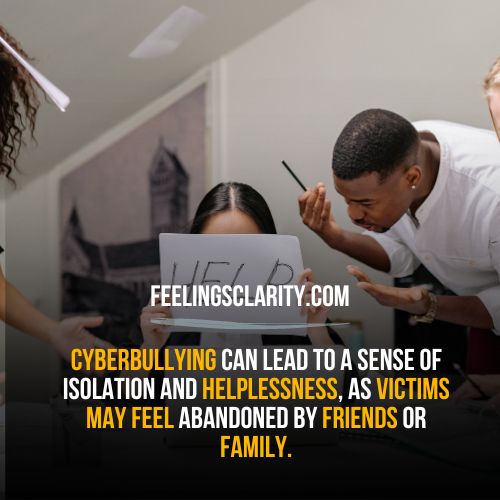In our increasingly interconnected world, the rise of cyberbullying has become a significant concern, affecting individuals across age groups and demographics. Cyberbullying involves the use of digital platforms to harass, intimidate, or harm others emotionally.
As a pervasive issue with profound consequences, understanding the emotional effects of cyberbullying is essential for addressing it effectively and providing support to victims. In this blog post, we delve into the emotional toll cyberbullying takes on individuals, exploring the anxiety, depression, anger, and other emotional responses it elicits.
We will also discuss the emotional impact of cyberbullying, its coping strategies, and the significance of cyberbullying prevention and education in creating a safe and supportive online environment.

Jump to a Specific Section
Definition of Cyberbullying
Cyberbullying refers to the use of electronic communication, such as social media, emails, or messaging apps, to engage in deliberate, hostile behavior toward others. This may involve sending hurtful messages, sharing embarrassing content, spreading rumors, or engaging in online harassment with the intention of causing emotional distress and harm.
1. Prevalence and Impact of Cyberbullying
The prevalence of cyberbullying has surged with the widespread use of digital devices and social media platforms. Its impact on victims is profound, affecting their emotional well-being, mental health, and overall quality of life.
Cyberbullying can lead to anxiety, depression, social isolation, and in extreme cases, even suicidal thoughts. Understanding the emotional consequences is critical to developing effective interventions and support systems.
2. Importance of Understanding the Emotional Effects
Recognizing and comprehending the emotional effects of cyberbullying is crucial for several reasons.
Firstly, it helps victims and those around them to empathize and provide appropriate support. Secondly, understanding the emotional toll enables parents, educators, and policymakers to take proactive steps to prevent and address cyberbullying more effectively. Lastly, it encourages us as a society to foster a compassionate and respectful online environment.
The Emotional Impact of Cyberbullying
1. Anxiety and Fear
- Fear of Being Targeted: Cyberbullying creates an atmosphere of constant fear for victims, knowing that they could be targeted and attacked at any moment online.
- Anxiety about the Unknown: The anonymous nature of cyberbullying leaves victims anxious about who the perpetrators might be, exacerbating their emotional distress.
2. Depression and Sadness
- Feeling Isolated and Helpless: Cyberbullying can lead to a sense of isolation and helplessness, as victims may feel abandoned by friends or family.
- Negative Self-Perception and Self-Doubt: Victims often internalize the hurtful messages they receive, leading to negative self-perceptions and feelings of inadequacy.
3. Anger and Frustration
- Resentment Towards Bullies: Victims may experience intense anger and resentment towards their bullies for causing emotional harm.
- Helplessness in Stopping Abuse: The inability to stop cyberbullying can lead to feelings of frustration and powerlessness.
Emotional Responses to Cyberbullying
1. Fight or Flight Response
- Adrenaline Rush and Hypervigilance: Victims may experience heightened anxiety, leading to an adrenaline rush, as they remain constantly alert to online threats.
- Escapist Behaviors and Avoidance: In an attempt to escape emotional distress, victims might resort to avoiding social media or online interactions altogether.
2. Emotional Numbing and Withdrawal
- Shutting Down Emotionally: Prolonged exposure to cyberbullying can lead to emotional numbness as a defense mechanism to protect oneself from pain.
- Social Isolation and Disengagement: Victims might withdraw from social activities or isolate themselves to shield themselves from further harm.
3. Self-blame and Guilt
- Internalizing Negative Messages: Victims often internalize the hurtful words directed at them, leading to feelings of self-blame and guilt.
- Believing They Deserve the Treatment: The constant barrage of negative messages may lead victims to believe they deserve the cyberbullying, further damaging their self-esteem.
Long-Term Emotional Effects of Cyberbullying
1. Post-Traumatic Stress Disorder (PTSD)
- Re-experiencing Trauma: Some victims may develop PTSD-like symptoms, reliving the cyberbullying experiences through flashbacks or nightmares.
- Hyperarousal and Hypervigilance: Emotional trauma may lead to a constant state of hyperarousal, making victims hyper-vigilant online.
2. Trust and Relationship Issues
- Difficulty in Forming and Maintaining Trust: The emotional betrayal experienced through cyberbullying can lead to difficulties in trusting others.
- Fear of Vulnerability and Emotional Intimacy: Victims might develop fear of emotional intimacy, fearing potential emotional harm from others.
Coping Strategies for Dealing with Cyberbullying
1. Reporting and Blocking Bullies
- Taking Action to Protect Themselves: Victims can take proactive measures by reporting cyberbullying incidents to relevant authorities or platform moderators.
- Reducing Exposure to Harmful Content: Blocking bullies and limiting exposure to harmful content can help protect victims from further emotional harm.
2. Seeking Professional Help
- Therapy and Counseling: Professional counseling can provide victims with coping mechanisms and emotional support to navigate the effects of cyberbullying.
- Learning Coping Mechanisms and Resilience: Therapy can help victims build resilience and emotional strength to overcome the emotional impact of cyberbullying.
Cyberbullying Prevention and Education
1. Building Empathy and Respect
- Fostering Understanding of Others’ Feelings: Promoting empathy helps individuals understand the emotional consequences of their actions online.
- Encouraging Kindness and Compassion: Instilling values of kindness and compassion can discourage cyberbullying behaviors.
2. Teaching Online Etiquette and Digital Responsibility
- Promoting Positive Online Behavior: Educating individuals about responsible digital conduct fosters a more respectful online environment.
- Empowering Bystanders to Intervene: Encouraging bystanders to stand up against cyberbullying can create a collective effort to prevent it.
Conclusion
In conclusion, cyberbullying inflicts a range of emotional responses and long-term effects on its victims. Understanding these emotional tolls is essential for providing appropriate support, developing effective interventions, and fostering a safe online environment.
By cultivating empathy, promoting positive online behavior, and teaching digital responsibility, we can collectively address cyberbullying and create a compassionate and respectful online community for everyone.
It is crucial to acknowledge that cyberbullying is a societal problem that requires a united effort to combat it, and together, we can create a safer and more supportive online environment for all.

FAQs on Cyberbullying
1. What is cyberbullying?
Cyberbullying refers to the use of digital communication tools, such as social media, texts, emails, or online platforms, to harass, intimidate, humiliate, or threaten another person.
2. How does cyberbullying differ from traditional bullying?
While traditional bullying typically occurs in person, cyberbullying takes place online. It involves using digital means to target individuals, often anonymously, which can intensify the reach and impact of the bullying.
3. What forms can cyberbullying take?
Cyberbullying can manifest in various ways, including sending hurtful messages, spreading false rumors, sharing embarrassing photos or videos, impersonation, exclusion, and public shaming.
4. What are the potential consequences of cyberbullying?
Cyberbullying can have severe emotional, psychological, and even physical consequences for victims. It may lead to anxiety, depression, low self-esteem, self-harm, academic or work problems, and in extreme cases, even suicide.
5. Who can be affected by cyberbullying?
Anyone who uses digital communication platforms can be a potential target of cyberbullying. This includes children, teenagers, adults, and even public figures.
6. How can someone recognize if they are being cyberbullied?
Signs of cyberbullying include sudden changes in behavior, withdrawal from social interactions, avoiding technology, and displaying signs of distress or sadness after using digital devices.
7. What steps should I take if I’m being cyberbullied?
If you’re a victim of cyberbullying, it’s important to: 1) Document the evidence, 2) Block or unfriend the bully, 3) Report the incident to the platform or website administrators, 4) Seek support from friends, family, or professionals, and 5) Practice online safety measures.
8. How can parents and guardians protect their children from cyberbullying?
Parents should communicate openly with their children about online behavior, set guidelines for internet use, monitor their online activity, educate them about privacy settings, and encourage open discussions about any negative experiences.
9. Are there legal consequences for cyberbullying?
Yes, cyberbullying can have legal consequences, especially if it involves threats, harassment, or the distribution of explicit content without consent. Laws vary by jurisdiction, but many places have enacted measures to address online harassment.
10. How can schools and organizations address cyberbullying?
Schools and organizations can implement anti-bullying policies, educate students and employees about responsible online behavior, offer counseling and support services, and promote a culture of respect and inclusivity.